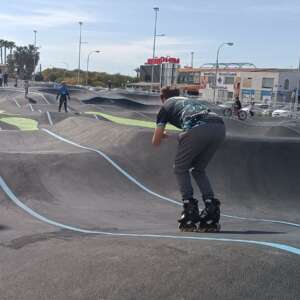
During the summer months of July and August, 259 people lost their lives on the roads of Spain, 34 more deaths than in the same period last year, representing an increase of 15%.
In July, 2018, there were 127 deaths due to traffic incidents on interurban roads, which showed an increase of 6 deaths compared to July last year. In the month of August, 2018, 132 people died in a traffic related incident, 28 more than in August of last year.
In terms of those who were injured to such an extent that they required hospitalisation, 491 people were injured in July and 413 in August.
Since the beginning of the period of monitoring, the summer of 2001, the data shows how there were 845 deaths in that first year. In the summer of 2010, there were 362 deaths, and 2014 saw the record low of 220 deaths, although still far too many. Since the year 2012, the number of deaths in the summer has varied in the range of between 220 to 260, thus averaging 240, and so this year´s 259 is well over that average number of deaths.
AUTONOMOUS COMMUNITIES OF SPAIN.
With respect to comparison of this year with the summer of 2017, the autonomous communities that have seen an increase in the number of deaths have been: Comunitat Valenciana (+13), Galicia (+11), Aragón and Castilla y León (+7), Canarias (+6), Catalonia, Comunidad Foral de Navarra and Basque Country (+3) and Región de Murcia (+1).
Andalusia, Principality of Asturias, Illes Balears, Cantabria, Castilla-La Mancha, Extremadura, Comunidad de Madrid and La Rioja presented decreases in regards to the number of deaths in traffic related incidents in the summer of 2018 in respect of 2017.

ACCUMULATION FOR THE YEAR
Since the beginning of the year until the 31 of August, 799 people have lost their lives, 24 more than in the same period of the previous year.
CHARACTERISTICS OF INCIDENTS
- Distribution of deaths by type of road:
| Deceased (24h) |
2017 |
2018 |
Differences 2018/2017 |
| Highways and motorways |
51 |
61 |
10 |
| Roads |
174 |
198 |
24 |
| Total |
225 |
259 |
34 |
*76% of fatalities were on secondary roads.
- Distribution of deaths by type of incident:
| Deceased (24h) |
2017 |
2018 |
Differences 2018/2017 |
| A front-end collision |
64 |
53 |
-11 |
| Side-impact collision and frontolateral |
28 |
40 |
12 |
| Rear-end collision and multiple |
22 |
13 |
-9 |
| Leaving the road |
77 |
108 |
31 |
| Rollover |
6 |
1 |
-5 |
| Hit a pedestrian |
16 |
24 |
8 |
| Another type |
12 |
17 |
5 |
| Without specifying |
0 |
3 |
3 |
| Total |
225 |
259 |
34 |
- Distribution of incident types on interurban roads:
|
Distribution % |
Road conventional. Year 2018 |
| A front-end collision |
29% |
| Side-impact collision and frontolateral |
15% |
| Rear-end collision and multiple |
2% |
| Leaving the road |
37% |
| Rollover |
1% |
| Hit a pedestrian |
10% |
| Another type |
5% |
| Without specifying |
1% |
| Total |
100% |
• Distribution of deceased by means of displacement:
| Means of displacement |
2017 |
2018 |
Differences 2018/2017 |
Percentage distribution |
| Pedestrians |
15 |
23 |
8 |
9% |
| Bike |
7 |
8 |
1 |
3% |
| Moped |
7 |
6 |
-1 |
2% |
| Motorcycle |
54 |
52 |
-2 |
20% |
| Vulnerable users |
68 |
66 |
-2 |
34% |
| Rest |
157 |
193 |
36 |
66% |
| Total |
225 |
259 |
34 |
100% |
• Distribution of deaths according to age:
|
Age group |
2017 |
2018 |
Dist % 2018 |
Differences 2018/2017 |
| Up to 14 years |
5 |
5 |
2% |
0 |
| 15 to 24 years |
30 |
35 |
14% |
5 |
| 25 to 34 years |
36 |
47 |
18% |
11 |
| 35 to 44 years old |
44 |
40 |
15% |
-4 |
| 45 to 54 years old |
43 |
40 |
15% |
-3 |
| 55 to 64 years |
39 |
40 |
15% |
1 |
| 65 to 74 years |
14 |
22 |
8% |
8 |
| 75 to 84 years |
8 |
16 |
6% |
8 |
| 85 years and over |
6 |
8 |
3% |
2 |
| Unknown |
0 |
6 |
2% |
6 |
| Total |
225 |
259 |
100% |
34 |
| 65 and over |
28 |
46 |
18% |
18 |
- Safety devices:
29 people killed in passenger cars were not using a seat belt at the time of the incident, which represents 23% of the total number of deceased in that type of vehicle.
Regarding the use of helmets, 1 moped rider and 2 other motorbike riders were not wearing a helmet at the time of the incident. In the case of the cyclists who died, all of them used a helmet.
The 5 children under the age of 12 years who died in passenger cars, or vans were using safety accessories.
DISPLACEMENT
During the months of July and August, there have been 88.5 million long-haul journeys by road, with an average of 2.8 million daily journeys, which represents an increase of 1% in respect of the journeys that were recorded last summer (87,7 million).
In July, there were 42.3 million long-distance movements, a decrease of 1% compared to July of last year.
In August, the increase was of 3% compared to the same month of the previous year. Specifically, in August, there were 46.3 million trips compared to the 44.9 million registered in August last year.
PREVENTIVE CAMPAIGNS
During the summer months, the DGT has deployed an intense activity of supervision and control of movement through different campaigns and actions.
During the two summer months, there were four special campaigns where they have intensified the surveillance of motorcycles, vans, speed and alcohol and other drugs.
The first of these campaigns saw the intensification of the surveillance of the conditions and manner in which motorcycles move. The officers from the Guardia Civil controlled 14.680 riders, who are responsible for 393. 80% of complaints on conventional roads.
The second of these campaigns had as its goal the intensification of the surveillance of the conditions and movement of vans. In five days, traffic officers detected 136 drivers of vans with the presence of alcohol or drugs in their body, 98 of them testing positive for alcohol and 38 for different types of drugs. In total, 37,200 people in vans were checked, of which 3,151 (8.5%) of drivers were reported for violating some form of traffic law.
In August, the month in which additional displacements are produced by road, the officers intensified checks on excessive or inappropriate speed, mainly on secondary roads. During that week (6 to 12 August) more than 380,000 vehicles were monitored, and 18.312 were reported by driving at speeds higher than permitted.
During the bridging holiday of August 15, there were increased controls on alcohol and other drugs, performing more than 64,500 tests. In three days, 1.133 drivers were detected behind the wheel having consumed some form of psychoactive substance.
VULNERABLE AND INAPPROPRIATE SPEED
The Director General of Traffic has noted that the data invites us to concentrate efforts on the roads, in the control of speed and distractions, and in the protection of vulnerable users.
Before the end, the Director General of Traffic has thanked “the effort and dedication of those who work every day for a safer mobility (agents of the Traffic Group of the Guardia Civil, staff of the Traffic Management Centres and helicopter patrols, as well as all the staff of the services and maintenance of roads, and emergency services). He also wanted to thank the majority of drivers for their prudence and responsibility that they put behind the wheel”.
















